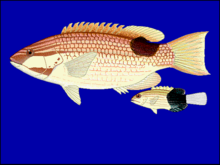| Bodianus bilunulatus | |
|---|---|

| |
| Conservation status | |
 Least Concern (IUCN 3.1) | |
| Scientific classification | |
| Domain: | Eukaryota |
| Kingdom: | Animalia |
| Phylum: | Chordata |
| Class: | Actinopterygii |
| Order: | Labriformes |
| Family: | Labridae |
| Genus: | Bodianus |
| Species: | B. bilunulatus |
| Binomial name | |
| Bodianus bilunulatus (Lacépède, 1801) | |
| Synonyms | |
| |
Bodianus bilunulatus, the tarry hogfish, is a species of wrasse native to the Indian Ocean from the African coast to the western Pacific Ocean to Japan, New Caledonia, and the Philippines.
Habitat
This species occurs on reef slopes at depths of from 3 to 160 m (9.8 to 524.9 ft) with the adults being found in deeper waters than the juveniles. This species can reach 55 cm (22 in) in total length with a maximum recorded weight of 1.8 kg (4.0 lb). It is of minor importance to local commercial fisheries and is also popular as a game fish. It can also be found in the aquarium trade. Other common names include: blackspot wrasse, crescent-banded hogfish, saddle-back hogfish, table boss, and tuxedo hogfish.
Taxonomy
The Hawaiian population of this species has been recently elevated to full species status based on some minor coloration differences, as Bodianus albotaeniatus.
References
- Russell, B. (2010). "Bodianus bilunulatus". IUCN Red List of Threatened Species. 2010: e.T187554A8566714. doi:10.2305/IUCN.UK.2010-4.RLTS.T187554A8566714.en. Retrieved 19 November 2021.
- Froese, Rainer; Pauly, Daniel (eds.). "Bodianus bilunulatus". FishBase. December 2008 version.
- Gomon, M.F., 2006. A revision of the labrid fish genus Bodianus with descriptions of eight new species. Rec. Aust. Mus. Suppl. 30:1-133.
- Randall, J.E., 2007. Reef and shore fishes of the Hawaiian Islands. Sea Grant College Program, University of Hawai'i, Honolulu. i-xivb + 1-546.
- Parenti, P. and J.E. Randall, 2011. Checklist of the species of the families Labridae and Scaridae: an update. Smithian Bull. 13:29-44.
| Taxon identifiers | |
|---|---|
| Bodianus bilunulatus | |
| Labrus bilunulatus | |
This Labridae article is a stub. You can help Misplaced Pages by expanding it. |